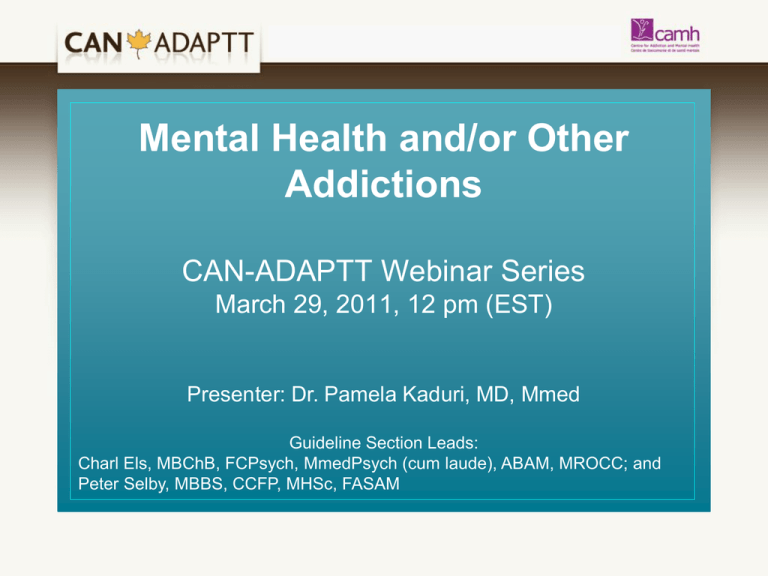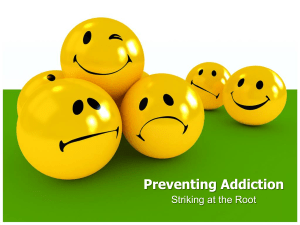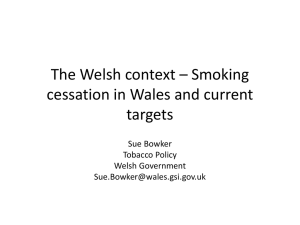Mental Health and Other Addictions webinar - CAMH
advertisement

Mental Health and/or Other Addictions CAN-ADAPTT Webinar Series March 29, 2011, 12 pm (EST) Presenter: Dr. Pamela Kaduri, MD, Mmed Guideline Section Leads: Charl Els, MBChB, FCPsych, MmedPsych (cum laude), ABAM, MROCC; and Peter Selby, MBBS, CCFP, MHSc, FASAM Bio & Disclosures Clinical Fellow, Addictions Program, Centre for Addiction and Mental Health (CAMH) TEACH program psychiatrist No affiliation with pharmaceutical industry or tobacco companies Guideline Development Group Peter Selby, MBBS, CCFP, MHSc, FASAM; Gerry Brosky, MD, MSc, CCFP; Charl Els, MBChB, FCPsych, MMed Psych (cum laude), Cert. ASAM, MRO; Rosa Dragonetti, MSc; Sheila Cote-Meek, BScN, MBA, PhD; Jennifer O’Loughlin, PhD; Paul McDonald, PhD, FRSPH; Alice Ordean, MD, CCFP, MHSc; Robert Reid, PhD, MBA Guideline Section Status This guideline section, “Mental Health and/or Other Addictions”, is currently under review by the GDG lead (Dr. Peter Selby). This section will be launched shortly. CAN-ADAPTT Guideline development, dissemination and engagement project Integrates practice, policy and research in a collaborative smoking cessation network Goal: To inform the development of a Pan-Canadian clinical practice guideline (CPG) for smoking cessation Funded by the Drugs and Tobacco Initiative, Health Canada National Network RESEARCH Practice-informed Research Agenda Clinical Practice Guideline Knowledge Translation Dissemination & Engagement PRACTICE Guideline Development Applied principles of ADAPTE… • Review existing CPGs • Highest-scoring CPGs included • Ongoing input from CANADAPTT network • GRADE framework used Grade of Recommendation High Strong Level of Evidence Weak Low 1A 2A 1B 2B 1C 2C Pregnant and Breastfeeding Women/ Femmes enceintes et qui allaitent Youth (Children and Adolescents)/ Jeunes (enfants et adolescents) Mental Health and/or Other Addictions/ Santé mentale et/ou autres dépendances Hospital-based populations/ Populations des hôpitaux Aboriginal Peoples/ Autochtones Various doors for intervention opportunities… Providing tobacco dependence treatment for mentally ill and addicted clients can be more complex than for other tobacco users Determinants of service depends on the seriousness of the mental illness and or treatment for substance use and the level of individuals functionality . Care can be through various doors Primary Health Care (PHC) Mental health treatment facility Substance use treatment facility Other community programs etc Gaps in Practice & Barriers NRT reduce to quit and combination therapy although approved for use in Canada has not been specifically studied in this population. Complexity of mental health patients and need for access to free pharmacotherapy. Monitoring for consequences of long-term use of medication. Gaps in practice and Barriers #2 Research targeted to address pharmacotherapy treatment and management (i.e.: higher doses of longer duration) for this population. Should approaches or interventions be tailored to different levels of mental health services (e.g. Crisis, first psychosis, etc.)? Summary Statement #1 Health care providers should screen persons with mental illness and/or addictions for tobacco use. GRADE: 1A Summary Statement #2 Health care providers should offer counseling and pharmacotherapy treatment to persons who smoke and who have a mental illness and/or addiction to other substances. GRADE: 1A Summary Statement #3 While reducing smoking or abstaining (quitting), health care providers should monitor the patient’s/client’s psychiatric condition(s) (mental health status and/or other addiction(s)). Medication dosage should be monitored and adjusted as necessary. GRADE: 1A Clinical Considerations Screen An equally accurate term for ‘screening’ may be ‘case finding’ given the prevalence of tobacco use among persons with mental health diagnosis and/or addiction(s). The term ‘addictions’ refers to those other than tobacco. Due to the high prevalence of concurrent mental illness and addiction, patients/clients should be screened for underlying, non-debilitating, undiagnosed mental health challenges. Conducting regular, brief screenings for mood changes is encouraged. Clinical Considerations cont’d Offer pharmacotherapy/counselling It should be noted that no (cessation) pharmacotherapy has been contraindicated in persons with mental illness unless medically contraindicated. Recognize that involuntary abstinence from tobacco requires management with an agonist at sufficient doses. The withdrawal/anxiety experienced by persons abstaining from smoking should be recognized and addressed; especially in acute care facilities. Clinical Considerations cont’d Monitor Consider that persons with mental illness and/or addiction(s) who smoke might need higher doses of NRT or combination therapies and for a longer duration. Assess for interactions with medications used for co morbid conditions. Caffeine should be considered a compound to be monitored. Clinical Considerations cont’d Follow-up Referral to appropriate healthcare services (community, program referral, other team members) for management/treatment and follow-up can be considered. In-patient staff should be aware of community resources to support cessation and address nicotine dependence. Clinical Considerations cont’d Resources for healthcare providers Treatment facilities staff should increase their understanding of mental health and nicotine dependence to effectively offer cessation and to address stigmas attached to mental illness. Additional Considerations Given the culture of mental health and addictions treatment facilities where staff often smoked and thereby, clients’ smoking behaviour was sustained, these facilities must address smoking in their policies. I.e. become smoke-free grounds. Offer smoking cessation to all healthcare providers and staff who smoke in a practice setting or treatment facility Financial resources for this “longer and stronger” counselling and/or pharmacotherapy are necessary. Persons with mental illness and/or addictions, due to a lower disposable income and proportionally higher spending on tobacco, may especially benefit from subsidized pharmacotherapy, in sufficient dose and duration. Limit out-of-pocket costs to smokers with mental illness and/or addictions to improve outcomes. Case #1 64 year old widowed woman, retired; husband recently died of heart disease . Smokes 20 cpd, on citalopram 30 mg daily for recurrent major depressive episodes, now in partial remission Has been thinking more about her smoking, but does not believe she can successfully quit because she quit smoking for 5 days once and felt terrible. She tried the nicotine lozenge but decided it didn’t help and says it’s expensive. She reports worries about the impact of her smoking on her grandchildren’s health, but fears gaining weight if she were to try to quit. She was recently diagnosed with very mild Type II Diabetes and encouraged to lose weight. She reports her morning routine is to make a pot of coffee and smoke her cigarettes while reading the newspaper. Case #2 34 year old married woman, employed in customer service at a telephone company She presents for outpatient psychotherapy with mild depressive symptoms . During the intake interview, the patient reports smoking 10 cigarettes a day, wanting to quit, but having just recently failed. She reports relapsing after a fight with her boss. Patient reports a history of disordered eating and concern about gaining weight when trying to quit smoking. Case scenario to think about! 45 year old woman, diagnosed with Bipolar 1 disorder for many years reports a history of daily smoking since age 17 , on ODSP and lives in a boarding home . Smokes about 2 to 3 packs per day. She reports to be smoking within 5 min of waking up and the morning cigarettes are hard to give up , she would smoke even in places where smoking is forbidden and would smoke even when physically ill. Her FTND was 9. Triggers include TV, waking up in the morning, stress, worsening of mental illness, and after meals. She is recently diagnosed with COPD , denies any other substance use. She has never tried to quit smoking before and is concerned what will happen when she no longer smokes as smoking has been part of her life and a sole friend. She however thinks that its about time she quits because of her COPD and financial situation. She has been on remission from her mental health problems for the last 5 years. Her last episode was 7 years ago when she had a suicidal attempt due to a depressive episode. Patient is now on Lithium 1200mg , Lamotrigine 60 mg, spiriva and ventolin puffers. She has a psychiatrist whom she sees on monthly basis. Tools/Resources Here to Help (BC Mental Health & Addiction Svcs) TEACH - specialized course on concurrent tobacco dependence and mental health and/or addictive disorders Nicotine Dependence Clinic (CAMH) Know of any others? Share them on www.can-adaptt.net Have additional feedback? 1. Join the network 2. Review the current version of the guideline 3. Provide your feedback online • Clinical considerations; tools/resources For more information CAN-ADAPTT Centre for Addiction and Mental Health 175 College St. Toronto, ON M5T 1P7 T: 416-535-8501 ext. 7427 www.can-adaptt.net Note: These presentation slides may be used or reproduced for educational purposes only. Please acknowledge authorship of this content to CAN-ADAPTT and CAMH.




